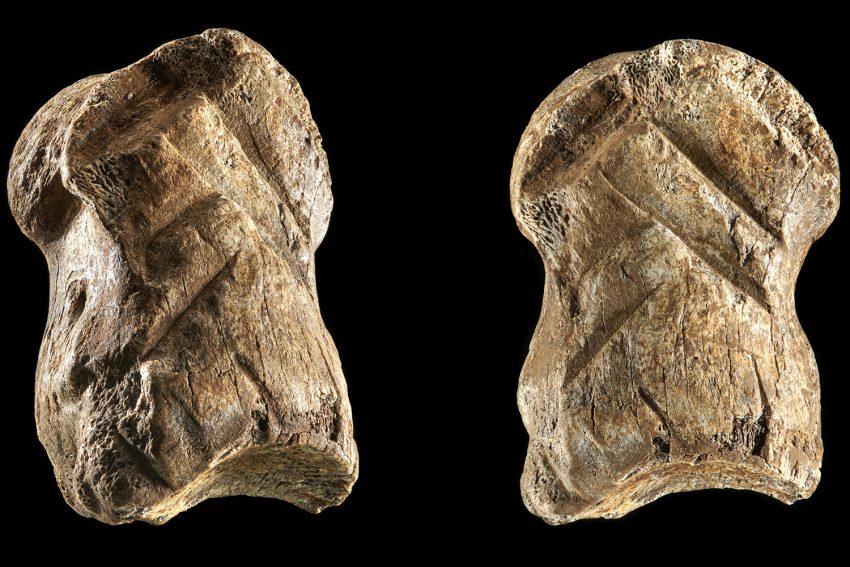Climate Change and Early Man research project launched Volkswagen Foundation funds research network with 1.6 million euros
With the project “Climate Change and Early Man”, a network of state-wide research competences of universities and institutes aims to gain new insights. The joint project is funded by the state of Lower Saxony and the Volkswagen Foundation with the “SPRUNG”, the former “Niedersächsisches Vorab”. The team from Technische Universität Braunschweig led by Professor Antje Schwalb from the Institute of Geosystems and Bioindication is involved.

The approximately 51,000-year-old decorated giant deer bone from the Unicorn Cave. Photo credit: V. Minkus, © NLD
Cultural heritage as an archive of the last 300,000 years
The state of Lower Saxony has a special cultural heritage from the Ice Age. The sites of Schöningen in the district of Helmstedt and Lehringen in the district of Verden have yielded the oldest preserved wooden hunting weapons known to man. From the Unicorn Cave in the Harz Mountains, an ornamented bone more than 50,000 years old was presented last summer, providing a crucial building block for understanding the cultural abilities of the Neanderthal.
These internationally important sites are also excellent archives that provide insights into the climate and environmental conditions of different time windows during the last 300,000 years. Researchers from the Universities of Braunschweig, Göttingen, Hanover and Lüneburg as well as from the Lower Saxony Institute for Historical Coastal Research in Wilhelmshaven, the Leibniz Institute for Applied Geophysics and the Lower Saxony State Office for the Preservation of Monuments in Hanover have joined forces to consistently develop and analyse these sources using state-of-the-art methods.
Better understanding of natural climate change
For this purpose, high-resolution geophysical measurements, drillings and excavations are carried out at various sites in Lower Saxony and the geological structures are then determined and evaluated in terms of their age with the help of geophysics, among other things. For the selected time periods, the environmental conditions are thus reconstructed in previously unknown resolution – among other things with the help of luminescence dating, old DNA, pollen and remains of mosquito larvae. The data obtained in this way, together with climate modelling, will contribute to a much better understanding of natural climate change, especially during earlier warm periods. At the same time, it will be clarified when and under which climatic conditions early humans were able to survive in northern Germany.
Braunschweig team investigates DNA of early humans
Of the total 1.6 million euros for three years, more than 437,000 euros of the funding amount will go to the Institute of Geosystems and Bioindication at TU Braunschweig. Among other things, this is intended to strengthen cooperation with the Helmholtz-Zentrum Hereon GmbH in the area of climate modelling. Dr. Katharina Dulias, Institute of Geosystems and Bioindication, will use the interdisciplinary approach of palaeogenetics to use ancient DNA from lake and cave sediments to reconstruct terrestrial vegetation and aquatic biodiversity. Ancient DNA and protein analysis will be used, for example, to be able to classify even small and fragmentary bone finds from the Unicorn Cave in the analysis of fauna. In addition, ancient DNA of early humans directly from the sediment layers and aquatic biodiversity will be studied. This method complements the use of aquatic microfossils, such as ostracodes (ostracods), chironomidae (lake flies) and diatoms (microalgae). These bioindicators make it possible to reconstruct the hydrology, temperature, water depth, plant nutrient load and salinity of a water body in the past. The combination of different methods should make it possible to get a much more accurate understanding of the past, as the methods used complement each other and each contributes individual data to an overall picture.
Braunschweig methodological approaches enable new results
Professor Antje Schwalb of the Institute of Geosystems and Bioindication at TU Braunschweig, and head of a sub-project, welcomes the fact that researchers in Lower Saxony working at the human-environment-climate interface will receive this additional funding for science and technology in research and teaching from SPRUNG funds. “I am particularly pleased that the reviewers emphasised the role of the methodological approaches chosen in Braunschweig.”
“A close interlocking of natural sciences and humanities with the state’s cultural institutions offers enormous opportunities for all cooperation partners,” says Lower Saxony’s Minister for Science and Culture, Björn Thümler. “With the globally unique sensational finds from Schöningen, archaeological monument preservation has provided research with objects that enable groundbreaking insights into the early history of mankind.”
The joint project will make the extraordinary cultural heritage of the Ice Age from Lower Saxony visible to science and the general public. In addition to the specialist journals, the results of the work will also be reported on in the Lower Saxony Monument Atlas and in the Forschungsmuseum Schöningen.
